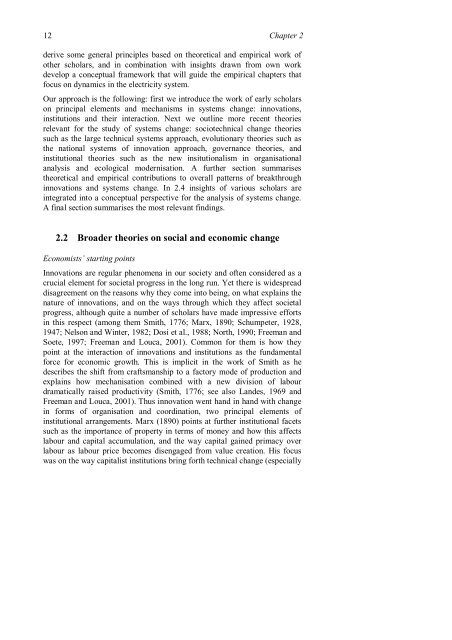Innovation and institutional change: the transition to a sustainable ...
Innovation and institutional change: the transition to a sustainable ...
Innovation and institutional change: the transition to a sustainable ...
You also want an ePaper? Increase the reach of your titles
YUMPU automatically turns print PDFs into web optimized ePapers that Google loves.
12 Chapter 2<br />
derive some general principles based on <strong>the</strong>oretical <strong>and</strong> empirical work of<br />
o<strong>the</strong>r scholars, <strong>and</strong> in combination with insights drawn from own work<br />
develop a conceptual framework that will guide <strong>the</strong> empirical chapters that<br />
focus on dynamics in <strong>the</strong> electricity system.<br />
Our approach is <strong>the</strong> following: first we introduce <strong>the</strong> work of early scholars<br />
on principal elements <strong>and</strong> mechanisms in systems <strong>change</strong>: innovations,<br />
institutions <strong>and</strong> <strong>the</strong>ir interaction. Next we outline more recent <strong>the</strong>ories<br />
relevant for <strong>the</strong> study of systems <strong>change</strong>: sociotechnical <strong>change</strong> <strong>the</strong>ories<br />
such as <strong>the</strong> large technical systems approach, evolutionary <strong>the</strong>ories such as<br />
<strong>the</strong> national systems of innovation approach, governance <strong>the</strong>ories, <strong>and</strong><br />
<strong>institutional</strong> <strong>the</strong>ories such as <strong>the</strong> new insitutionalism in organisational<br />
analysis <strong>and</strong> ecological modernisation. A fur<strong>the</strong>r section summarises<br />
<strong>the</strong>oretical <strong>and</strong> empirical contributions <strong>to</strong> overall patterns of breakthrough<br />
innovations <strong>and</strong> systems <strong>change</strong>. In 2.4 insights of various scholars are<br />
integrated in<strong>to</strong> a conceptual perspective for <strong>the</strong> analysis of systems <strong>change</strong>.<br />
A final section summarises <strong>the</strong> most relevant findings.<br />
2.2 Broader <strong>the</strong>ories on social <strong>and</strong> economic <strong>change</strong><br />
Economists’ starting points<br />
<strong>Innovation</strong>s are regular phenomena in our society <strong>and</strong> often considered as a<br />
crucial element for societal progress in <strong>the</strong> long run. Yet <strong>the</strong>re is widespread<br />
disagreement on <strong>the</strong> reasons why <strong>the</strong>y come in<strong>to</strong> being, on what explains <strong>the</strong><br />
nature of innovations, <strong>and</strong> on <strong>the</strong> ways through which <strong>the</strong>y affect societal<br />
progress, although quite a number of scholars have made impressive efforts<br />
in this respect (among <strong>the</strong>m Smith, 1776; Marx, 1890; Schumpeter, 1928,<br />
1947; Nelson <strong>and</strong> Winter, 1982; Dosi et al., 1988; North, 1990; Freeman <strong>and</strong><br />
Soete, 1997; Freeman <strong>and</strong> Louca, 2001). Common for <strong>the</strong>m is how <strong>the</strong>y<br />
point at <strong>the</strong> interaction of innovations <strong>and</strong> institutions as <strong>the</strong> fundamental<br />
force for economic growth. This is implicit in <strong>the</strong> work of Smith as he<br />
describes <strong>the</strong> shift from craftsmanship <strong>to</strong> a fac<strong>to</strong>ry mode of production <strong>and</strong><br />
explains how mechanisation combined with a new division of labour<br />
dramatically raised productivity (Smith, 1776; see also L<strong>and</strong>es, 1969 <strong>and</strong><br />
Freeman <strong>and</strong> Louca, 2001). Thus innovation went h<strong>and</strong> in h<strong>and</strong> with <strong>change</strong><br />
in forms of organisation <strong>and</strong> coordination, two principal elements of<br />
<strong>institutional</strong> arrangements. Marx (1890) points at fur<strong>the</strong>r <strong>institutional</strong> facets<br />
such as <strong>the</strong> importance of property in terms of money <strong>and</strong> how this affects<br />
labour <strong>and</strong> capital accumulation, <strong>and</strong> <strong>the</strong> way capital gained primacy over<br />
labour as labour price becomes disengaged from value creation. His focus<br />
was on <strong>the</strong> way capitalist institutions bring forth technical <strong>change</strong> (especially
















